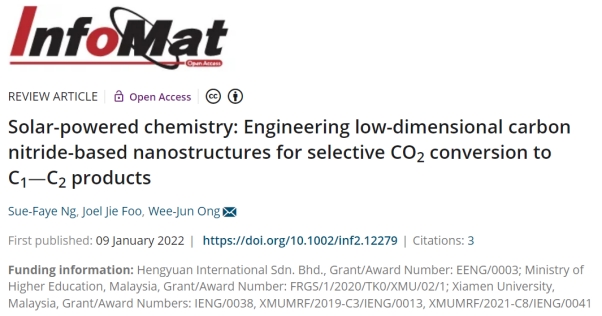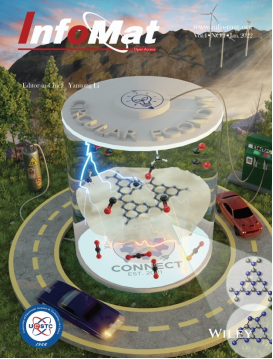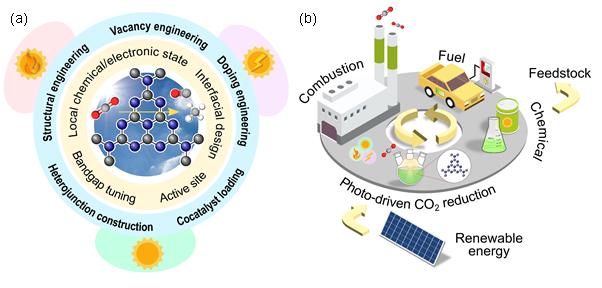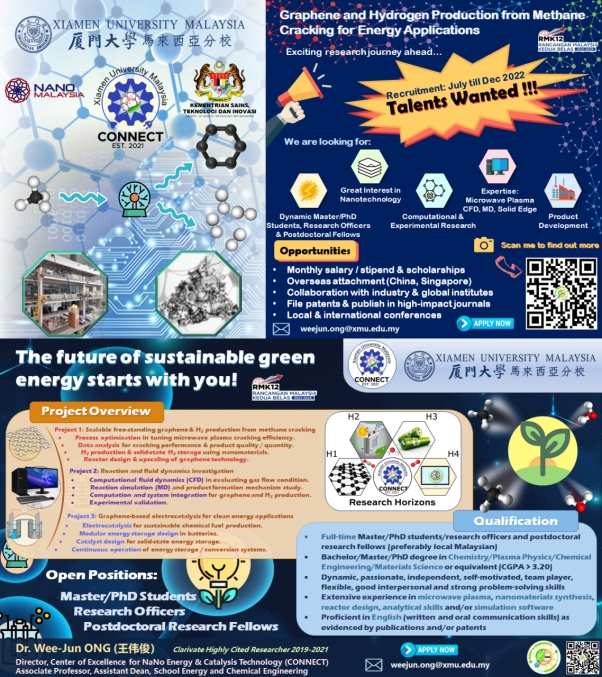Congratulations to postgraduate students, Ng Sue-Faye and Joel Foo Jie from XMUM School of Energy and Chemical Engineering, who have published a review article in InfoMat, an interdisciplinary open-access Q1 journal in materials science research with a latest impact of 24.798
This paper has been listed as one of the Top 1% Highly Cited Papers as of March/April 2022 by the Clarivate Analytics. Associate Professor Dr. Ong Wee Jun from XMUM School of Energy and Chemical Engineering is the research supervisor and the corresponding author.

https://doi.org/10.1002/inf2.12279
This work was an invited article by the InfoMat editors for a themed issue, “Carbons for Energy Storage and Conversion”, while its figure was selected by editors for the issue’s Back Cover.

Figure 1: Back cover image for the themed issue “Carbons for Energy Storage and Conversion” in InfoMat.
The article, titled “The Solar-powered chemistry: Engineering low-dimensional carbon nitride-based nanostructures for selective CO2 conversion to C1-C2 products”, presents the latest panorama of experimental and computational research on tuning the local electronic, surface chemical coordination environment, charge dynamics, and optical properties of low-dimensional carbon nitride and its allotropes toward highly selective and efficient CO2 photoconversion. In addition, critical insights are elucidated to establish the structure performance relationship and unravel primary factors dictating the selectivity of C1-C2 molecules from CO2 reduction. Furthermore, the authors discussed the external-field assisted photocatalysis to uncover the synergistic contributions that drive the development of photochemistry. In conclusion, future challenges and prospects are outlined for the potential application of solar-driven CO2 conversion.
The authors would like to acknowledge the funding from the Ministry of Higher Education (MOHE) Malaysia under the Fundamental Research Grant Scheme (FRGS) (Ref no: FRGS/1/2020/TK0/XMU/02/1), Xiamen University Malaysia (Grant no: IENG/0038, XMUMRF/2021-C8/IENG/0041 and XMUMRF/2019-C3/IENG/0013), and Hengyuan International Sdn. Bhd. (Grant no: EENG/0003).

Figure 2: (a) Overview of our work in InfoMat and (b) a circular carbon economy for photo-driven CO2 reduction toward energy sustainability.
Sue-Faye NG | “The process of writing this review gave me insights into the selective transformation of CO2 to valuable products to better our society. With the rise of global CO2 emissions, I believe that this is a prospective avenue to explore for the well-being of the future generations. I would like to thank my supervisor, Dr. Ong Wee Jun, for providing me with this opportunity to expand my knowledge and writing skills.” |
Joel Jie FOO | “I am honored to publish my work in InfoMat. Writing this review is like taking a short journey into the realm of nanomaterials and being amazed by the wonder of photocatalysis. A well-defined nanostructured carbon nitride is like a hand of Midas that can turn waste into gold. In view of the ever-increasing CO2 atmospheric concentration, a technology that can make use of the CO2 and turn them into a valuable product or energy-intensive chemical is the key to advancing into a sustainable future. At last, I would like to thank Dr. Wee-Jun Ong and Sue-Faye Ng for their guidance and support in completing such an amazing work and I would continue to pursue my research for net zero carbon production.” |
Wee-Jun ONG | Wee-Jun Ong received his BE and PhD in Chemical Engineering from Monash University. He is an Associate Professor and Assistant Dean at School of Energy and Chemical Engineering, Xiamen University Malaysia. Starting in 2021, he becomes the Director of Center of Excellence for NaNo Energy & Catalysis Technology (CONNECT). Previously, he was a scientist at Agency for Science, Technology and Research (A*STAR), Singapore. In 2019, he was a visiting scientist at Technische Universität Dresden and a visiting professor at Lawrence Berkeley National Laboratory. His research interests include nanomaterials for energy storage devices, photocatalytic, photoelectrocatalytic, and electrochemical H2O splitting, CO2 reduction and N2 fixation. For more details, refer to https://sites.google.com/site/wjongresearch/.
|
Recruitment: Postgraduate Opportunity under Dr. Ong’s Supervision at CONNECT, XMUM
Dr. Ong is actively recruiting and eagerly looking for several enthusiastic research talents (Masters candidates, PhD Candidates, Research Officers and Postdoctoral Research Fellows) for a funded sustainable energy project from the Malaysian government. In line with the 12th Malaysian Plan (RMK12), the primary focus of the national priority project is on microwave plasma-driven methane cracking for the scalable production of free-standing graphene and hydrogen alongside solid-state hydrogen storage. The project will be under Center of Excellence for Nano Energy & Catalysis Technology (CONNECT) at Xiamen University Malaysia (XMUM). The preferred start time is August 2022 (imminent start).
If you are interested to work in this inspiring project, kindly contact Dr. Ong Wee Jun for further discussion (weejun.ong@xmu.edu.my). Please look at the promotional banner below for more details.










